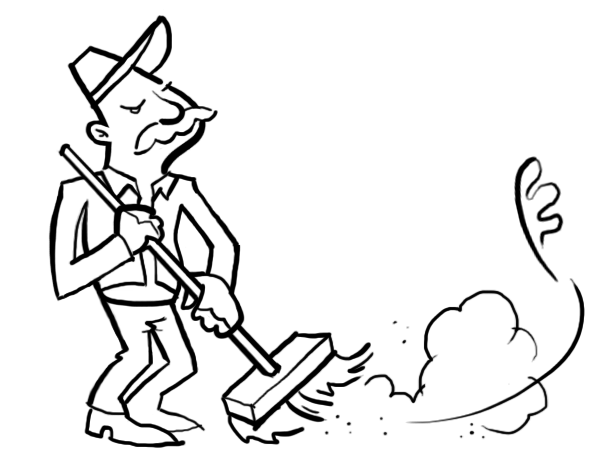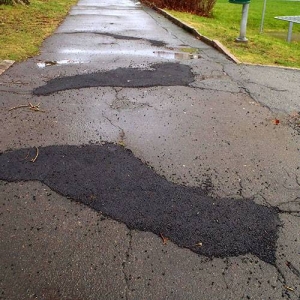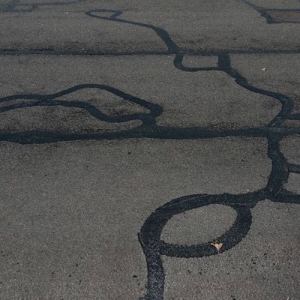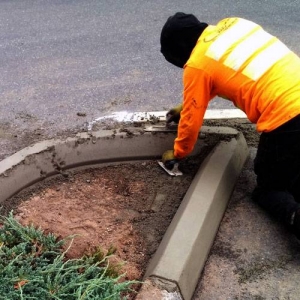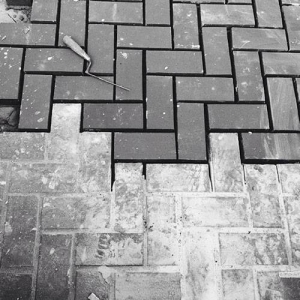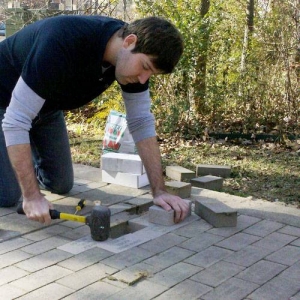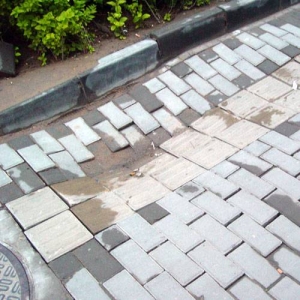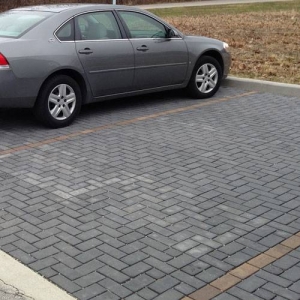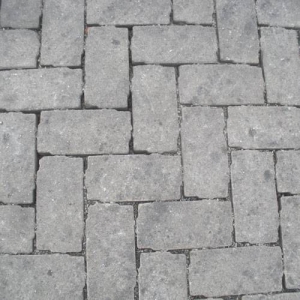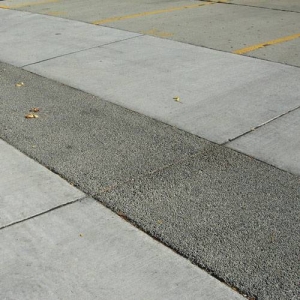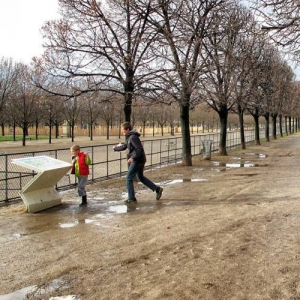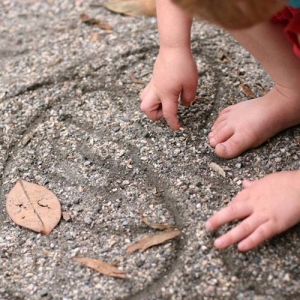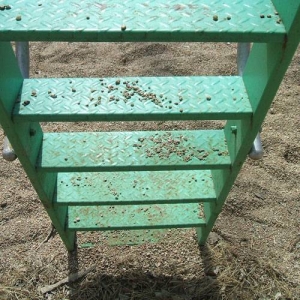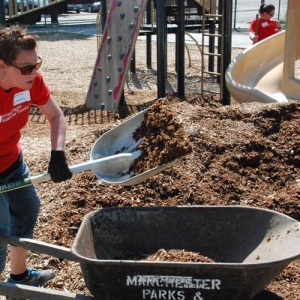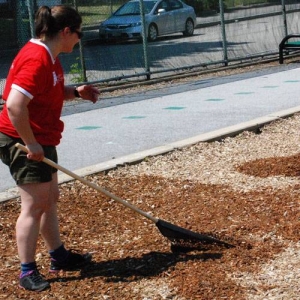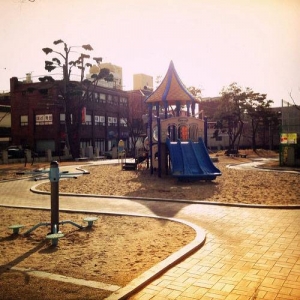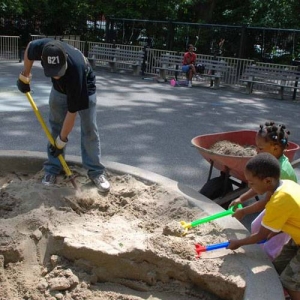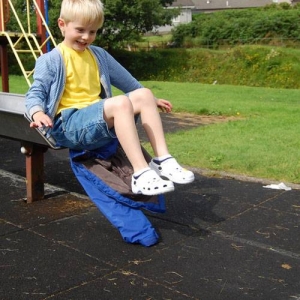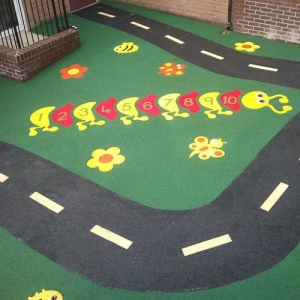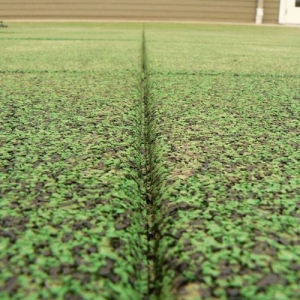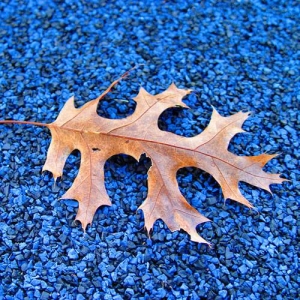Asphalt and Concrete
Asphalt, concrete, and other poured surfaces are known as “bonded” surfaces. This makes them very durable, and implementing them is relatively inexpensive. However, over time they will crack due to to the ground settling or shifting combined with the lack of flexibility in the material. This happens to a greater extent in colder climates because of the temperature extremes and the freeze/thaw cycle. Tree roots can also push up on the pavement from underneath, causing cracks and bumps. Potholes develop when the ground settles unevenly, leaving a hole or depression under the pavement into which the material eventually collapses.
What does that mean for maintenance? Well, the lifespan of these ground surfaces can be extended quite a bit by patching up cracks and holes. Asphalt cracks can be patched easily with a crack filler. For holes, an easy method is a cold mix of soft asphalt that is poured into the the hole and tamped down, but it is not the strongest solution. A more permanent fix is to use a hot mix, which is heated road-grade asphalt that becomes very hard and strong when it’s completely cooled. Repairing concrete is much the same, but with different materials of course: a concrete or cement patch mix or resurfacer.
If a paved surface is severely damaged, it may need to be ripped out and completely replaced. However, these surfaces can be repaired many times before they get to that point.
Pavers and Bricks
Using pavers for ground surfaces is a bit more expensive up-front but it has its advantages. Brick and paving units (usually made of precast concrete) have small spaces between them, which gives them the ability to conform to the ground as it shifts, unlike solid asphalt or concrete. If the ground becomes uneven to the point where the pavers are no longer level with each other, it can be a tripping hazard. Luckily, repairs are easy. Individual pavers can be removed and the base course (usually crushed gravel) can be smoothed out below before putting the pavers back in. If any of the pavers break, they can be taken out and replaced with new ones. No obvious repair patchwork means that surfaces with this type of paving will age gracefully and look like new for much longer.
Permeable Pavement
Permeable pavement can be in the form of pavers with specially designed gaps or porous concrete. These gaps and “pores” let water through and they can, over time, become clogged with fine sediment. This can be reduced by sweeping dust, sand, and debris away regularly. Power washing can blast out clogs that a broom can’t reach. For serious clogging, there are vacuums designed for removing sediments that are deeply embedded in the paved surface. These three strategies will keep permeable pavement at tip-top shape.
Gravel
Gravel paths and walking surfaces are usually compacted, making them easy to travel on and fairly durable against the elements. It can, however, get uneven over time due to foot traffic and rain. This unevenness can lead to puddles forming in depressions, and runoff from heavy rain can carve out channels if a site doesn’t have adequate stormwater management. Gravel surfaces will need to be topped up every once in a while with new gravel to fill in any unevenness and replace what has been washed away.
Loose gravel surfaces for play areas or planting areas are usually made of larger, heavier particle sizes and are contained with solid borders like curbs to contain it, making them less susceptible to erosion. It is still more or less inevitable that some gravel will escape, requiring some occasional tidying with a broom to keep surrounding hard surfaces gravel-free. Twigs and other debris might find their way into gravel. These can be easily picked or raked out.
Sand, Wood Chips, and Other Loose Surfaces
Sweeping and picking out debris also applies to sand and wood chips. These materials are inadvertently kicked out of their retaining borders through spirited play and some sweeping will be required. They will also need to be topped up once in a while. Wood chips in particular need to be added every few years because they gradually biodegrade.
Rubber Surfacing
Rubber is a very low maintenance material. Debris should be regularly swept off to reduce the risk of slipping, and to remove anything that might cause undue wear and tear on the rubber. Dirt and spills can be cleaned easily; just don’t use any harsh chemicals that could break down the binding agents in the rubber, which could lead to a shortened lifespan of the material.
